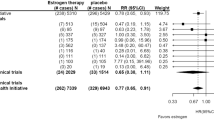Abstract
Objective: We hypothesized that variations in the ESR2 gene may influence estrogen exposure in the uterus and thus influence endometrial cancer risk. We validated and screened for variants in the ESR2 gene and examined whether they are associated with endometrial cancer risk.
Methods: We resequenced the promoter and coding regions of the ESR2 gene in 24 endometrial cancer cases, and genotyped the validated/discovered SNPs and intronic dinucleotide CA repeat in a nested case–control study of endometrial cancer (cases = 222, controls = 666) in the Nurses' Health Study (NHS). We also explored statistical interaction between ESR2 genotypes and body mass index (BMI) or hormone replacement therapy (HRT) use among postmenopausal women and cancer risk.
Results: Two SNPs were validated [rs1256049 in exon 5 (allelic frequencies = 98% G, 2% A) and rs1271572 in the promoter region (allelic frequencies = 60% G, 40% T)]. After adjusting for potential confounders, we observed no association between ESR2 gene polymorphisms and endometrial cancer risk [rs1256049 (OR = 1.2; 95%CI: 0.7–2.3), rs1271572 (OR = 0.8; 95%CI: 0.5–1.1) and CA repeat (22 repeat allele versus≥22 repeat allele, OR = 1.1; 95%CI: 0.7–1.7)]. We also did not observe any significant effect modification of the ESR2 polymorphisms by BMI or HRT use among postmenopausal women.
Conclusion: Our results indicate that ESR2 polymorphisms may not be associated with endometrial cancer risk.
Similar content being viewed by others
References
Henderson BE, Feigelson HS (2000) Hormonal carcinogenesis. Carcinogenesis 21: 427–433.
Enmark E, Pelto-Huikko M, Grandien K, et al. (1997) Human estrogen receptor beta-gene structure, chromosomal localization, and expression pattern. J Clin Endocrinol Metab 82: 4258–4265.
Lecce G, Meduri G, Ancelin M, Bergeron C, Perrot-Applanat M (2001) Presence of estrogen receptor beta in the human endometrium through the cycle: expression in glandular, stromal, and vascular cells. J Clin Endocrinol Metab 86: 1379–1386.
Krege JH, Hodgin JB, Couse JF, et al. (1998) Generation and reproductive phenotypes of mice lacking estrogen receptor beta. Proc Nat Acad Sci 95: 15677–15682.
Westberg L, Baghaei F, Rosmond R, et al. (2001) Polymorphisms of the androgen receptor gene and the estrogen receptor beta gene are associated with androgen levels in women. J Clin Endocrinol Metab 86: 2562–2568.
Comings DE (1998) Polygenic inheritance and micro/minisatellites. Mol Psychiatry 3: 21–31.
Ogawa S, Hosoi T, Shiraki M, et al. (2000) Association of estrogen receptor [beta] gene polymorphism with bone mineral density. Biochem Biophys Res Commun 269: 537–541.
Lau HH, Ho AY, Luk KD, Kung AW (2002) Estrogen receptor beta gene polymorphisms are associated with higher bone mineral density in premenopausal, but not postmenopausal southern Chinese women. Bone 31: 276–281.
Forsell C, Enmark E, Axelman K, et al. (2001) Investigations of a CA repeat in the oestrogen receptor beta gene in patients with Alzheimer's disease. Eur J Hum Genet 9: 802–804.
Eastwood H, Brown KM, Markovic D, Pieri LF (2002) Variation in the ESR1 and ESR2 genes and genetic susceptibility to anorexia nervosa}. Mol Psychiatry 7: 86–89.
Arko B, Prezelj J, Komel R, Kocijancic A, Marc J (2002) No major effect of estrogen receptor beta gene RsaI polymorphism on bone mineral density and response to alendronate therapy in postmenopausal osteoporosis. J Steroid Biochem Mol Biol 81: 147–152.
Sundarrajan C, Liao WX, Roy AC, Ng SC (2001) Association between estrogen receptor-beta gene polymorphisms and ovulatory dysfunctions in patients with menstrual disorders. J Clin Endocrinol Metab 86: 135–139.
Zheng SL, Zheng W, Chang BL, et al. (2003) Joint effect of estrogen receptor beta sequence variants and endogenous estrogen exposure on breast cancer risk in Chinese women. Cancer Res 63: 7624–7629.
De Vivo I, Huggins GS, Hankinson SE, et al. (2002) A functional polymorphism in the promoter of the progesterone receptor gene associated with endometrial cancer risk. Proc Natl Acad Sci USA 99: 12263–12268.
Rosenkranz K, Hinney A, Ziegler A, et al. (1998) Systematic mutation screening of the estrogen receptor beta gene in probands of different weight extremes: identification of several genetic variants. J Clin Endocrinol Metab 83: 4524–4527.
Li LC, Yeh CC, Nojima D, Dahiya R (2000) Cloning and characterization of human estrogen receptor beta promoter. Biochem Biophys Res Commun 275: 682–689.
Author information
Authors and Affiliations
Corresponding author
Rights and permissions
About this article
Cite this article
Setiawan, V.W., Hankinson, S.E., Colditz, G.A. et al. Estrogen Receptor β lpar;ESR2) Polymorphisms and Endometrial Cancer (United States). Cancer Causes Control 15, 627–633 (2004). https://doi.org/10.1023/B:CACO.0000036170.28502.5f
Issue Date:
DOI: https://doi.org/10.1023/B:CACO.0000036170.28502.5f




